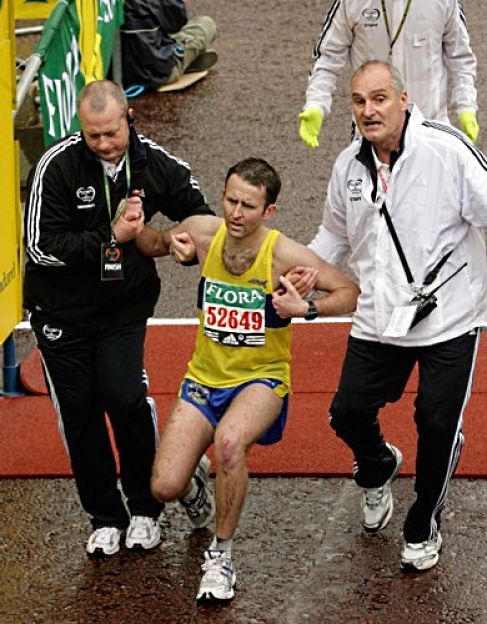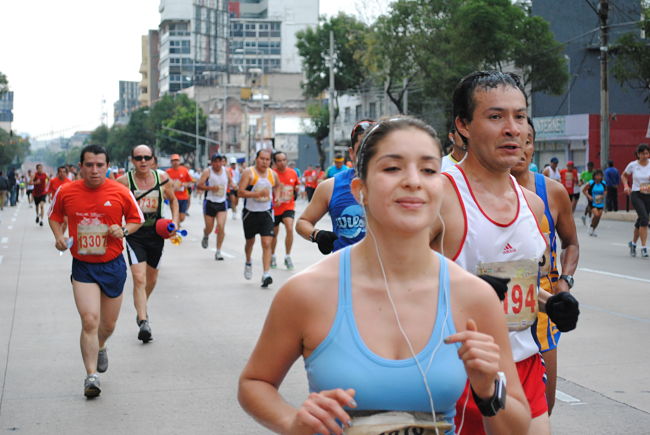Running a Marathon - What are the Dangers and Health Risks
Running a marathon of 26 miles and 385 yards (42.2 kilometres) puts a huge strain on the body and may take a competitor to the limit of their endurance and beyond if they experience the famous and much feared effect of 'hitting the wall'.
This is a bout of severe exhaustion caused by the body running out of vital carbohydrates. Runners can become sluggish and lose coordination and the ability to concentrate, reaction time slows down, and balance start to go, and runners may feel light-headed.
You may recall the famous images of runners staggering towards the finish line determined to finish but totally exhausted. What are the dangers of going through this and the severe strain and exhaustion on your respiratory and muscle systems?
Is pushing your body that hard, dangerous and are there long term, and well as short term risks, of running a marathon? Do people die running marathons?

The concept of risk is one of those things that everyone talks about but few people really understand and how to put it in the right perspective. Most Australians live near the coast and love to go surfing, or enjoy relaxing at the beach. Some people won't go swimming in the ocean because they are afraid of the sharks. What they don't realise is that the risk of injury and death when driving to the beach, is thousands of times higher that the risk of shark attack.
Nevertheless going swimming in the ocean is a conscious decision. It does entail a suite of risks that people should be aware of, and need to assess before entering the water. Some of these risks will be general ones and some will be more specific. The risks of drowning are higher if the surf is rough and there are rips, if the person is a poor swimmer or inexperienced, or the person is swimming at night on an unpatrolled beach.This is when the sharks are lurking and there's no one to save you.
Similar issues apply to running a marathon - it depends on the weather conditions, the course and also how old and fit you are, and how much training you have done. This article aims to provide a review the risks, so that people can make an informed decision for themselves about the health dangers of running a marathon.
Lets look as some of the major types of risks and their cause
Sprains and Strains - Most of the casualties that occur during marathon races are relatively minor injuries, such sprains and strains. The damage may be increased because they may occur when runners are very tired and people may not heed the warning signs, and push on trying to reach the finish line. Most of these injuries can probably be avoided by warming up and adequately stretching before the race and by adequate and prolonged training using a plan.
Dehydration is one of the biggest problems that marathon runners have to overcome. Entire books have been written about this topic as hydration management can be quite complex because of the delay between when you take a drink and how quickly this relieves the symptoms. It may be hard to get enough fluid back into the body's systems once dehydration has begun to set it. When you start to feel thirsty may be out of alignment with your body's extreme dehydration state. Many of the few deaths that have occurred during marathons have been linked with dehydration. Many people who get distressed and are taken to hospital are dehydrated. At least one runner has died of drinking too much!
In a tough race on a humid and very hot day, a runner can lose up to four litres of fluid during the race through sweating and exhalation of breath. How many runners drink this much fluid during the race?
It is vital that runners to keep well hydrated. (See Running a Marathon | How much Fluid Should you Drink during a Race?).
Injuries During Marathons
There are excellent statistic available for injuries and deaths during marathons. The London Marathon is a competitive event but is also a large, celebration and social sporting festival. Of the 37,500 people who took part in the 2012 London Marathon, total of 4,923 runners and general members of the public (13%) needed some form of assistance, mostly for very minor problems, with some repeats. In 2011, a total of 6,000 competitors required assistance - many for heat exhaustion caused by the hot weather during the 2011 marathon event.
A research study examined the frequency and type of leg injuries incurred by athletes taking part in the New York City Marathon in 1994. A total of 265 athletes who sought help at medical stations were surveyed during the 1994 New York City Marathon. The study showed that people who trained more had fewer injuries. This was consistent with long-term studies of training and running injuries.
Of the 265 injured athletes surveyed (see the images for details):
- 75% were male.
- 20% were younger than 30 years of age
- 35% were aged between 30 and 40 years
- 30% were older than 40 years of age
- 98% stated they took part in a regular stretching program
- More than half of the injuries occurred in runners who trained between 0 to 40 miles per week
- Less than 10% of all injuries occurred in those who ran more than 80 miles per week
- the most common injuries occurring in marathon runners were blisters, muscle cramps, calluses, corns, acute knee and ankle injuries, plantar fascilitis (foot arch), and metatarsalgia (pain in the forefoot).


Deaths During Marathons
Fatalities are very rare in the London Marathon. The 30-year-old woman who collapsed and died near the finish of the 2012 London Marathon is the first woman of the 11 competitors to die since start of the marathon in 1981.
- Follow-up research has shown that 7 of these 11 deaths ( more than half) had been linked to heart and circulation problems such as blocked heart blood vessels or congenital heart defects. Five of the 7 with heart conditions had signs of coronary artery disease and 2 had structural problems with their hearts.
- All were aged over 40 years
- One man died due to drinking too much water
- Two runners died from brain haemorrhages.
Similarly, US research studies have examined almost 11 million runners who contested half-marathons and marathons between 2000 and 2010. Over the ten years, 59 contestants had a cardiac arrest and 42 of these people died. This is equivalent to one death in every 259,000 runners.
Other studies have estimated that for male runners aged 30-64 years with no known heart disease problems, there have been about one death for each 800,000 'person-hours' of jogging or running during training and race events.
To put these figures in terms of a risk or probability, healthy males aged from 30-64 years who run for about one hour every day are at risk of dying while running once every 2,000 years. Individuals who run two hours every day are at risk of dying while running or jogging about once in every 1,000 years.
Comparative Mortality Risks for Various Activities
In the table below the estimated lifetime risk for various activities has been estimated by dividing the total US population in 2003 (290,850,005) by the reported number of deaths, dividing by 78, which is the average the life expectancy for people born in 2003. Some extra data has been added for marathons and running.
The comparative data shows that the risk of death while running or while running in a marathon, is roughly equivalent to that of death cause by lightning strikes or shark attacks.
Of course this does not include the reduce risks of heart attack, stroke and being overweight through undertaking regular exercise and being physically fit and in shape.
So if you don't swim in the ocean because you are afraid of sharks, you would probably not want to take up running or compete in marathon races.
Relative Risk Of Death for Various Activities
|
Disease and Accidental Causes of Deaths
|
Annual Deaths
|
Risk of Death During a Lifetime
|
|---|---|---|
|
Heart disease
|
652,486
|
1 in 5
|
|
Cancer
|
553,888
|
1 in 7
|
|
Stroke
|
150,074
|
1 in 24
|
|
Hospital Infections
|
99,000
|
1 in 38
|
|
Flu
|
59,664
|
1 in 63
|
|
Car accidents
|
44,757
|
1 in 84
|
|
Suicide
|
31,484
|
1 in 119
|
|
Accidental poisoning
|
19,456
|
1 in 193
|
|
Falls
|
17,229
|
1 in 218
|
|
Drowning
|
3,306
|
1 in 134
|
|
Bike accident
|
762
|
1 in 4,919
|
|
Plane Crash
|
742
|
1 in 5,051
|
|
Excessive Cold
|
620
|
1 in 6,045
|
|
Sun / Heat exposure
|
273
|
1 in 13,729
|
|
Lightning
|
47
|
1 in 79,746
|
|
Train crash
|
24
|
1 in 156,169
|
|
Fireworks
|
11
|
1 in 340,733
|
|
Shark attack
|
1
|
1 in 3,748,061
|
|
Risk
|
||
|
Marathons 42 deaths; 11 million
|
1 in 260,000
|
|
|
Running 1 death in 800,000 hours
|
1 in 800,000
|
Tips for Reducing the Risks by Ensuring You are Fit Enough to run?
- If you have any medical issues which you think may put you at risk, you should see your GP before you begin training for a race.
- People with existing conditions like heart disease or diabetes should also seek medical advice.
- Once you start training, increase running distances gradually to avoid exhaustion and separate your days of heavy mileage with one or two days of lighter training or rest, so that your body can recover.
- Always follow a training plan to prepare for the race. All of the websites for the major events have excellent training plans for various categories of runners By following a training plan you will be able to build stamina. However, if you become ill or injured during this training period, take a break. Do not start training again until you have fully recovered. And, again, seek medical help if you need to.
- As a rule of thumb, experts advise that, a month before the race, you should be able to "comfortably" run a continuous 15 miles. By comfortably, they mean that you should feel as though you could still run more at the end of the distance.
- You should also notify the event organisers of any medical conditions that you have and should not compete if you do not feel fit on the day of the race.
- On the day of your event, remember to warm up, pace yourself and to rest if you feel pain or discomfort.
Related Articles
=> Resistance Band Exercise Routines, Pros and Cons, Tips and Guides
=> Homemade Sports Drinks for Revitalizing After Exercise
=> Exercise Intensity, Duration, Frequency are Vital for Fitness, Losing Weight
=> Watermelon Juice Relieves Post-Exercise Muscle Soreness, Other Health Benefits
=> How You Respond to Exercise – Some Do, Some Don’t, Depends on Genes
=> Training Plateau Definition - Great Tips for Breaking Through Exercise Plateaus and Barriers
=> Stretching Exercises Before a Run or Workout May NOT Reduce Injuries
=> How to Increase Your Vertical Jump - Best Exercises, Training Tips
=> Exercise Prolongs Life - Which Type, How Much and Best Intensity?
=> How to Beat the Set Point Limit in Daily Exercise Routines
=> Q&A: Why Does Exercise Makes You Feel Good & Improve Your Physical and Mental Health
=> Tight Hamstrings - Causes, Treatment and Exercises to Stretch, Loosen
=> Short Intense Exercise Routines for Men, Women - Something Old is New Again
=> Isometrics Exercising Equipment with Pressure App, Hand Exercise Ball



